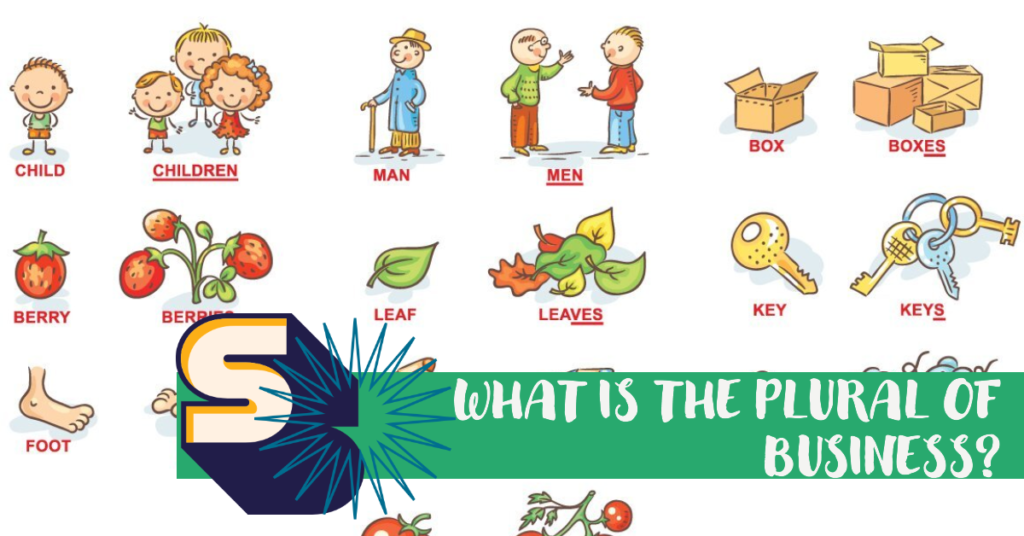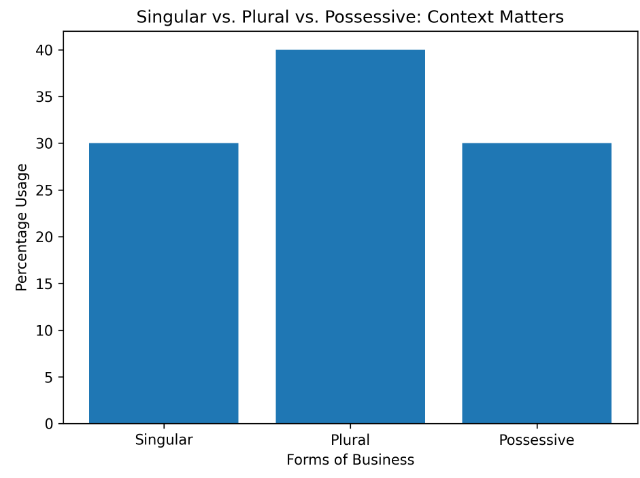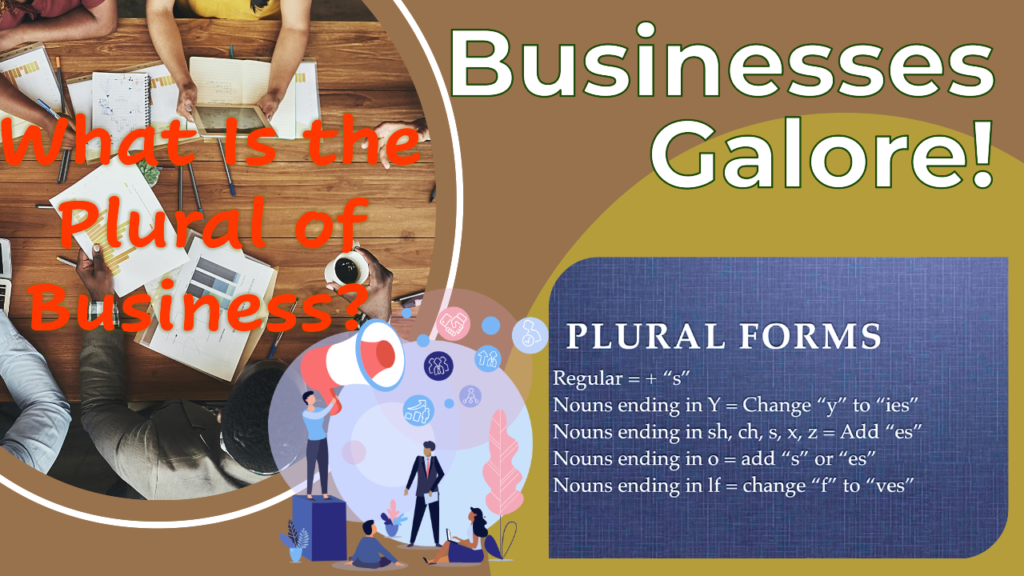Communication is essential in the hectic world of business. When you are in the business world, getting your message across clearly is everything. Sending that important email, pitching to investors, or reporting analytics – how you phrase things matters big time.
Now, you have likely used the word “business” a million times without thinking about it too hard. But have you considered if you are using the plural or possessive form correctly? It may seem trivial, but knowing your “businesses” from your “business’s” is critical to come across as an expert. Mess it up, and you risk confusing people or looking like a rookie.
This guide will break down the grammar behind business plurals and possessives. We’ll tackle the nitty-gritty details so you can chat business lingo with confidence. No more mix-ups that derail your message or unintentionally undermine your professionalism. We’ll uncover the intricacies of this deceivingly simple word.
By the end, you will have the skills to eloquently discuss enterprises of every size and type – and not embarrass yourself in the process! Sound good? Let’s get to it and dissect this multifaceted noun once and for all.
What is the Plural of Business?
The singular form of the word “business” is straightforward, but what about its plural form? The plural form of the word “business” is “businesses.” To make it plural, you simply add “es” to the end of the singular noun, transforming “business” into “businesses.” This plural form is used to refer to multiple businesses or a collection of businesses. In fact, “business” has two different plural forms – the regular plural “businesses” and the irregular plural possessive form “business’s.”

“Businesses” is used when referring generally to more than one business. For example:
- There are many new businesses opening in our city.
- Local businesses were offering holiday discounts.
“Business’s” is used when attributing possession or ownership to multiple businesses. Some examples are:
- The business’s hours of operation are 9 am – 5 pm.
- The business’s products have increased in popularity.
The key difference between “businesses” and “business’s” is that the latter denotes a specific association or possession, while “businesses” is a general plural. Understanding when to use each plural form correctly is important for clear communication.
Why is it Important to Know the Plural of Business?

- Avoid Spelling Mistakes: Knowing the difference between “business” and “businesses” can save you from spelling mistakes that could undermine your credibility.
- Clear Communication: In business documents, using the correct plural form ensures that your message is understood as intended.
- Professionalism: Using the correct plural form of business in your communications reflects well on your professionalism and attention to detail.
- Legal Documents: In contracts and legal agreements, a singular or plural form mistake could lead to misinterpretations and legal complications.
How to Use the Plural of Business Correctly in a Sentence
- When Referring to Multiple Entities: Use “businesses” when you are talking about more than one business. E.g., “There are several businesses in the area that offer similar services.”
- Ownership or Possession: When indicating ownership or possession for multiple businesses, the plural possessive form would be “businesses’”. E.g., “The businesses’ profits have increased this year.”
- In Formal Writing: Always adhere to style guides and grammar rules when using the plural form of business in formal documents.
- Pronunciation: The plural form, “businesses,” adds an extra syllable. Make sure your pronunciation reflects this.
The Fundamentals of English Grammar
A Brief Overview of Singular, Plural, and Possessive Forms in English
- Singular Nouns: These are nouns that do not end in “s” and represent one entity. E.g., “The singular form of ‘business’ is ‘business.'”
- Plural Nouns: These are nouns that end in “s” or “es” and represent multiple entities. E.g., “The plural form of business is ‘businesses.'”
- Possessive Nouns: These indicate ownership or possession. E.g., “The possessive form of business is ‘business’s’ or ‘business’.'”
The Role of Apostrophes in Forming Possessive Nouns
- Adding an Apostrophe: To form a singular possessive, simply add an apostrophe and an “s” to the end of the singular noun. E.g., “The business’s profits are soaring.”
- Apostrophe at the End: For plural possessive nouns, place the apostrophe at the end of the word. E.g., “The businesses’ combined revenue exceeded expectations.”
- Apostrophe Rules: Grammar rules dictate that the singular possessive form uses “’s” while the plural possessive form uses “s’”. E.g., “The difference between business’s and businesses is the placement of the apostrophe.”
- Avoid Confusion: Knowing the difference between singular, plural, and possessive forms can help you avoid spelling mistakes and grammar errors.
You will be better able to communicate clearly and effectively, whether in formal writing or professional email if you comprehend these English grammatical foundations.
Singular vs. Plural vs. Possessive

- Singular (30%): Used when referring to a single entity or concept.
- Plural (40%): Used when discussing multiple entities or concepts.
- Possessive (30%): Used to indicate ownership or a specific relationship to a single or multiple entities.
Plural vs. Possessive Forms of Business
| Form | Example | Explanation |
|---|---|---|
| Singular | Business | Refers to one entity, e.g., “The business is thriving.” |
| Plural | Businesses | Refers to multiple entities, e.g., “Several businesses are participating in the fair.” |
| Singular Possessive | Business’s | Indicates ownership by one business, e.g., “The business’s profits are up.” |
| Plural Possessive | Businesses’ | Indicates ownership by multiple businesses, e.g., “The businesses’ combined revenue was impressive.” |
Understanding the difference between business’s and businesses is crucial for clear and accurate communication. The possessive form of the word business, whether singular or plural, is used to show ownership or possession. Knowing when to use business’s or businesses can save you from grammar errors and spelling mistakes.
When to Use the Plural Form of Business
Knowing when to use the plural form of business, which is ‘businesses,’ is crucial for effective communication. Here are some scenarios where you should opt for the plural form of the word:
- Multiple Entities: When discussing more than one business. E.g., “Local businesses are participating in the community fair.”
- Various Types of Businesses: When referring to different kinds of companies. E.g., “The various types of businesses in the area include tech startups and restaurants.”
- Collection of Businesses: When talking about a group of companies. E.g., “A collection of businesses signed the petition.”
- Multiple Businesses in Context: When the context involves more than one company. E.g., “These businesses are part of the same industry.”
When to Use the Possessive Form of Business
Understanding when to use the possessive form of business can be a bit tricky. Here’s a guide to help you:
- Ownership or Possession: When indicating that something belongs to one business, use business’s. E.g., “The business’s profits are high.”
- Multiple Owners: When something belongs to more than one business, use businesses’. E.g., “The businesses’ combined revenue is substantial.”
- Specific Rules: Always add an apostrophe at the end for plural possessive. E.g., “Two businesses’ CEOs met for a summit.”
- End of the Word: The possessive form of business usually involves adding an apostrophe at the end or between the letters. E.g., “The business’s strategy is effective.”
By following these guidelines, you can avoid spelling mistakes and adhere to English grammar rules, ensuring that your writing is both accurate and professional.
Singular vs. Plural: Context Matters
| Context | Singular: Business | Plural: Businesses |
|---|---|---|
| Ownership | “The business’s strategy is effective.” | “The businesses’ CEOs met for a summit.” |
| Count | “One business is leading in innovation.” | “Several businesses are contributing to the project.” |
| General Reference | “The business is part of the tech sector.” | “These businesses are part of the same industry.” |
When to Use ‘Business’ and When to Opt for ‘Businesses’
- Use ‘Business’: When referring to a single entity. E.g., “The business is booming.”
- Use ‘Businesses’: When referring to multiple entities. E.g., “Local businesses are thriving.”
Real-World Examples Illustrating Correct Usage
- Singular: “The business’s new marketing strategy has increased sales.”
- Plural: “Local businesses are participating in the community fair.”
By understanding these grammar rules, you can ensure your language is both accurate and precise.
Common Mistakes People Make with the Plural and Possessive Forms of Business
- Confusing Plural with Possessive: One of the most common grammar mistakes is confusing the plural form “businesses” with the possessive form “business’s.”
- Incorrect Apostrophe Placement: Many people mistakenly place the apostrophe before the ‘s’ in the plural form, writing “business’es” instead of “businesses.”
- Omitting the Apostrophe in Possessive Form: The possessive form of business should be “business’s,” but people often forget to add an apostrophe and write it as “business.”
- Using Plural Form for Singular Reference: Sometimes, people use the plural form of business, “businesses,” when referring to a singular business.
- Incorrect Use in Sentences: The plural and possessive forms are often used incorrectly within the context of a sentence, affecting the meaning of business statements.
- Ignoring Style Guides: Different style guides have specific rules for plural and possessive forms, which people often overlook.
- Assuming All Nouns Follow the Same Rule: Not all plural nouns end in ‘s,’ and the possessive form can vary, leading to spelling mistakes.
- Incorrect Pronoun Usage: Using the wrong pronoun for singular or plural forms can also lead to confusion.
- Overlooking the Need for Notarization: In legal documents, getting the plural and possessive forms correct is crucial, and mistakes can lead to issues that may require notarization to resolve.
You may prevent these mistakes and improve your English grammar by understanding the difference between the plural and possessive forms of the word business.
The Role of Style Guides in Business Writing
- Standardization Across Platforms: One of the key benefits of using style guides is that they bring uniformity to business writing, whether it’s emails, reports, or contracts.
- Clarity on Plural and Possessive Forms: Style guides offer specific guidelines on how to correctly use the plural and possessive forms of business, reducing the risk of spelling mistakes and grammar errors.
- Enhanced Credibility: Consistency in language and style boosts your business’s credibility. A misplaced apostrophe or incorrect plural form of business can undermine professionalism.
- Legal Implications: Inaccurate use of plural and possessive forms in legal documents can lead to misunderstandings and potential legal repercussions. Style guides help in maintaining the correct form of business terms.
- Global Communications: For businesses or a collection of businesses operating internationally, adhering to a recognized style guide ensures that the meaning of business communications is clear to all parties, regardless of their native language.
- Efficiency and Productivity: Time spent debating over the correct form of the word “business” is time wasted. Style guides offer quick references to resolve such issues, allowing staff to focus on achieving business goals.
- Quality Assurance: Following a style guide is a form of quality control for business writing, ensuring that all communications meet a certain standard.
Adhering to a style guide ensures your business communications are clear, consistent, and professional, beyond mere rule-following.
The plural form of “business” is “businesses.”
No, the standard plural form for the word “business” is “businesses.”
To pluralize “business,” you add “es” at the end, making it “businesses.”
Yes, the general rule for forming plurals in English is to add “s” or “es” to the singular noun, although there are many exceptions.
The possessive form of “business” is “business’s,” as in “the business’s profits.”
The plural of “business” is written as “businesses.”
The correct spelling for the singular possessive form of “business” is “business’s.”
The singular possessive form of “business” is “business’s,” as in “the business’s assets.”

Conclusion
In wrapping up, mastering the plural and possessive forms of ‘business’ is more than a grammatical nicety—it’s a business imperative. The difference between ‘business’s’ and ‘businesses’ can change the meaning of a sentence, affecting legal documents, contracts, and even your company’s reputation.
Style guides are not just academic exercises; they are practical tools that ensure consistency and clarity in business communications. So, don’t overlook these grammar rules. They can be the difference between a successful business communication and a confusing one.
Take this knowledge and apply it diligently in your professional life. After all, in the world of business, every word counts.
Muhammad Asif Saeed has extensive experience in commerce and finance. Specifically, He holds a Bachelor of Commerce degree specializing in Accounts and Finance and an MBA focusing on Marketing. These qualifications underpin his understanding of business dynamics and financial strategies.
With an impressive 20-year career in Pakistan’s textile sector, including roles at Masood Textile (MTM) and Sadaqat Limited, excelling in business & financial management. His expertise in financial and business management is further evidenced by his authoritative articles on complex finance and business operation topics for various renowned websites including businessproplanner.com,businesprotips.com,distinctionbetween.com, trueqube.com, and bruitly.com, demonstrating his comprehensive knowledge and professional expertise in the field.


🚀 Wow, blog ini seperti roket melayang ke alam semesta dari kemungkinan tak terbatas! 🌌 Konten yang menarik di sini adalah perjalanan rollercoaster yang mendebarkan bagi imajinasi, memicu kegembiraan setiap saat. 💫 Baik itu gayahidup, blog ini adalah harta karun wawasan yang inspiratif! #TerpukauPikiran 🚀 ke dalam petualangan mendebarkan ini dari imajinasi dan biarkan pikiran Anda terbang! 🌈 Jangan hanya menikmati, rasakan sensasi ini! #BahanBakarPikiran Pikiran Anda akan berterima kasih untuk perjalanan menyenangkan ini melalui dimensi keajaiban yang penuh penemuan! 🌍
Thanks
nice content!nice history!! boba 😀
nice content!nice history!! boba 😀
nice content!nice history!! boba 😀
wow, amazing
📝 I’m bookmarking this post for future inspiration! 📝
Thanks
🌌 Wow, blog ini seperti petualangan fantastis meluncurkan ke alam semesta dari kegembiraan! 🎢 Konten yang menegangkan di sini adalah perjalanan rollercoaster yang mendebarkan bagi pikiran, memicu ketertarikan setiap saat. 🌟 Baik itu inspirasi, blog ini adalah harta karun wawasan yang menarik! 🌟 Terjun ke dalam pengalaman menegangkan ini dari penemuan dan biarkan imajinasi Anda melayang! 🚀 Jangan hanya menikmati, alami sensasi ini! 🌈 🚀 akan bersyukur untuk perjalanan mendebarkan ini melalui alam keajaiban yang penuh penemuan! ✨